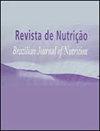帕金森病患者的食物消耗、人体测量和身体组成
IF 0.5
4区 医学
Q4 NUTRITION & DIETETICS
Revista De Nutricao-brazilian Journal of Nutrition
Pub Date : 2022-01-01
DOI:10.1590/1678-9865202235e220058
引用次数: 0
摘要
目的本研究的目的是评估慢性非传染性疾病的风险和保护性食品的消费,并调查帕金森病患者的人体测量参数和身体成分的关系。方法采用病例系列研究方法,对门诊就诊的79例男女成人及老年患者进行分析。使用食物频率问卷来评估食物摄入量,以确定每日食用较多的食物,并按性别分层。每种食物的消费频率被转换成两类食物特征的分数:风险和保护。这个概念模型考虑了社会人口学、行为和人体测量变量以及身体成分。结果72.1%的调查对象体重超标,43.5%的调查对象体脂超标。身体质量指数高、体脂率高的人食用保护性食物的几率更高。结论食物摄入、体脂与慢性非传染性疾病之间存在反向因果关系,揭示了两者之间关系的复杂性。本文章由计算机程序翻译,如有差异,请以英文原文为准。
Food consumption, anthropometry and body composition of patients diagnosed with Parkinson’s disease
ABSTRACT Objective The aim of the present study was to evaluate the consumption of risk and protective foods for chronic noncommunicable diseases and to investigate associations with anthropometric parameters and body composition in individuals with Parkinson’s disease. Methods A case-series study was conducted with 79 adult and elderly patients of both genders in outpatient care. Food intake was evaluated using a food frequency questionnaire for the identification of foods with greater daily consumption, stratified by gender. The consumption frequency of each food was converted into scores of two food groups characteristics: risk and protection. The conceptual model took into account sociodemographic, behavioral and anthropometric variables as well as body composition. Results A total of 72.1% of the participants in the sample had excess weight based on the body mass index and 43.5% had excess body fat. The consumption of protective foods was greater among individuals with a higher body mass index and with a greater rate of body fat. Conclusion The data indicate a situation of reverse causality and reveal the complexity of the relationship among food intake, body fat and chronic noncommunicable diseases.
求助全文
通过发布文献求助,成功后即可免费获取论文全文。
去求助
来源期刊
CiteScore
1.20
自引率
12.50%
发文量
24
审稿时长
6-12 weeks
期刊介绍:
Revista de Nutrição is former Revista de Nutrição da Puccamp, founded in 1988. It is a bimonthly publication every four months and it is of responsibility of the Centro de Ciências da Vida, da Pontifícia Universidade Católica de Campinas . It publishes articles that contribute to the study of Nutrition in its many sub-areas and interfaces; and is open to contributions of the national and international scientific communities.

 求助内容:
求助内容: 应助结果提醒方式:
应助结果提醒方式:


